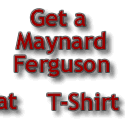
Home ![]() Articles
Articles
![]() Features
Features ![]() Maynard Ferguson
Maynard Ferguson
Maynard Ferguson
Printed in the November/December, 1987 issue of Windplayer magazine.
[Excerpted by permission from Windplayer magazine, issue #14. Copyright 1988 Windplayer Publications.]
By Harvey Siders
There are any number of memorable things about Maynard Ferguson. His chops. His inexhaustible energy. His remarkable success in India where he teaches each year as official Visiting Professor of Western Music. And, of course, his long survival in the mercurial world of music, perhaps because of his ability to change with the times...from big band, to mainstream combos, to fusion.
Any of the above would make a subject for a fascinating profile. But in the many interviews this writer has conducted with Maynard, the trait I find most memorable is the fact that his answers seldom bear any relation to my questions.
Every time I talk to the guy, I'm amazed by the bitonality of our conversations. We're in different keys, yet somehow we manage to communicate. Eventually he gets around to addressing the topic I may have raised three choruses earlier.
Since our most recent interview-during the photo session in Hollywood that resulted in the insightful cover of this issue - I've played and replayed the audio tape of our conversation. At the same time, I've been recuing the video on my mental VCR - Maynard sitting there, nervously fidgeting with his horn, looking everywhere except at his interviewer, those legendary lips constantly moving, even when no sound emerges.
About those chops: They're better than ever, as evidenced by his brand new album, High Voltage (Intima, SJ-732790). Surrounded by half a dozen like-minded swingers, Maynard proves that he is up to his old tricks with a new combo - allowing his firmly planted bop roots to be nurtured in an avant-garden of synthesized fusion. He enjoys, and flourishes in, the best of both worlds - which is what fusion is all about, n'est-ce pas?
Mind you, it is not merely a juxtaposition of jazz and rock. Maynard is too careful in his selection of sidemen, too dedicated to swinging to allow an unsubtle rock pulse to impede the flow of his jazz playing. High Voltage (the name of his septet as well as its album) is a thoroughly integrated combo, each sideman boasting bilingual pedigrees, constantly inspiring, often challenging their father figure out front. As Maynard explained his criteria: "Nobody gets on my band today unless they're great acoustical jazz players and unless they can delve equally in the the computerized sounds of today."
On the heels of that bit of pontification, Maynard suddenly looked back, reminiscing about his days with the Kenton band. It was January 1, 1950. Maynard had just left Canada in a blinding blizzard and had so much trouble making connections that he arrived three hours late for his very first rehearsal. The band was all in place, "with one trumpet chair empty," when Maynard made his grand entrance - "carrying my fur coat, my fur hat and my fur boots." He still remembers Kenton's booming greeting. "Ferguson, where the hell have you been?"
But, as Maynard notes, Stan was laughing.
There was never a shortage of laughs after that, nor of high notes - both literally and symbolically. Maynard had come a long way from his teen-age gig as co-leader, with his brother, of his first big band: The Montreal High School Victory Serenaders, with fellow Canadian Oscar Peterson on piano and vocals. (Although Maynard is currently based in Ojai, California, and holds a Resident Alien card permitting him to live permanently in the U.S., he is still a Canadian citizen.) "Sure, I miss the big band," he admits. "And sure, I had a ball with the thirteen-piece band I brought over from England. But High Voltage gives me a chance to play more. I'm the only trumpet player."
In his Kenton days, he was hardly the only trumpet player. Between 1950 and '53, he kept some high-voltage company in Stan's ever-changing trumpet section: Pete and Conte Candoli, Buddy Childers, Shorty Rogers, Chico Alvarez, Ray Wetzel, Stu Williamson; those are only some of the trumpeters Maynard recorded with during that three-year stretch.
He feels that today's young musicians are less likely to be content with being "lost" in a high caliber section. "Considering the quality of the players coming out of the colleges and conservatories today, it's no wonder they all want to play more. It's almost impossible to find a kid with that 'Boy am I happy just to be here playing third trumpet on this band' attitude. The third trumpet is wondering when he's going to get a shot at the lead book. The fourth trumpet knows he can play jazz better than the guy taking the solos.
"Perhaps I'm being unfair, but I can't help thinking about the groove Basie hit, mainly because of the attitude of his players. Players you can't remember now. Fourth trumpet. Third trombone. Fourth tenor. They're the guys who loved what they did and they made that band. That's missing today. I usually feel like saying, 'Hey! Just play your parts, kids.'
"That reminds me of the kids who come up to me after a concert and say, 'My dad played some old Kenton recordings for me and wow!' If I can get them to name certain tunes, I'll tell them, 'That's me right there.' They say, 'Yeah, I know,' and I'll say, 'No. That's me on fifth trumpet.'
"Sometimes I'm convinced I was the best fifth trumpet player Stan ever had. I wasn't built to play the bottom register. Before I went with Kenton, I never played fourth or fifth trumpet in my life and it was a challenge. But I loved it. I took great pride. I try to convince my students that there is genuine fun in playing the heck out of the fifth trumpet part."
The word "students" led due East - to India, where, for the past ten years, Maynard has been involved in spiritual as well as musical fusion. "I've been teaching formally for the past ten years, but my interests in India and its philosophies and values go back many years before that. I'd reached a point where I was playing the same way, the same music, to the same audiences at the same venues. It was an age of rebellion and I was getting restless. I wanted to see what was on the other side. I also wanted my children to get something a little different than they got in the local schools. And I guess, most important, it's the gypsy adventure spirit with me."
Perhaps the gypsy in his soul helped influence him to become a devotee of Sathya Sai Baba, guru of an ecumenical system of belief based in Bangalore, near the southern tip of India. As Maynard describes it, "When you walk into the temple, you see a huge statue of Christ, along with Krishna, Buddha and representatives of all the major faiths. It freaks the Christians to see such ecumenism but, as Baba preaches, 'Come to me to be better at what you are, not to change who you are.'"
Maynard loves teaching in India, and is constantly amazed at the lack of disciplinary problems, which he attributes to a philosophy that preaches obedience "to mother, to father and to teacher." When fellow musicians ask him how it is for an instructor in Indian schools, Maynard often chides them with, "Just like teaching in South Philly, man."
He also loves immersing himself in Indian music. "They are so sophisticated rhythmically and we in the West have so much to offer them harmonically."
For Maynard, that translates into the ultimate fusion, a musical and spiritual high voltage that guarantees him the best of both worlds - perhaps even the next, considering how he can improvise on his Karma.

